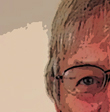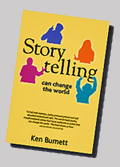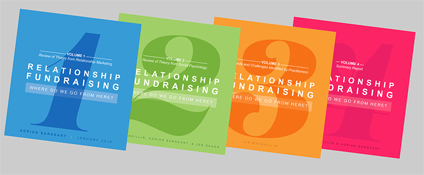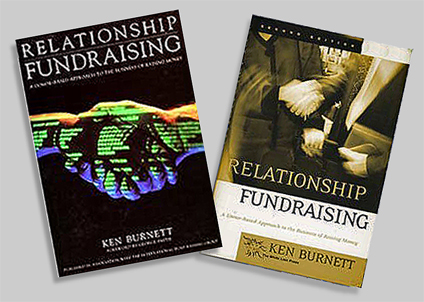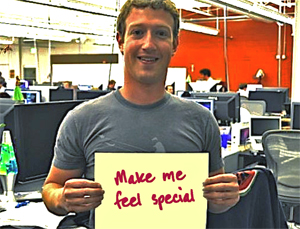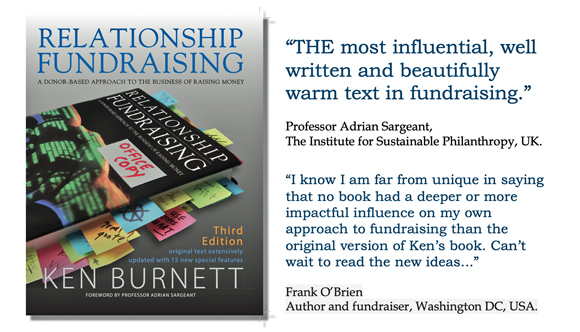|
Blog 15th Feb 2016. ...more user-friendly and considerably closer to the great big point-of-view that I wanted the book to have on its publication. It was with a distinct sense of foreboding that I greeted the news that the renowned professor Adrian Sargeant and his colleagues at the Centre for Sustainable Philanthropy were embarking upon a detailed academic study of relationship fundraising This prodigious piece of work is not for those whose interests in the topic are frivolous or superficial. Still I prefer the subtitle and keeping it simple.
|
No one’s been more surprised than I by the durability of my book Relationship Fundraising (first edition by The White Lion Press, London 1992, second edition from Jossey-Bass Inc, San Francisco, 2002). In the introduction to the first edition I explained that I only ever aspired to sell a mere 50 copies, one each to the 50 non-profits I hoped then would become clients of my London-based marketing and communications agency, Burnett Associates. Though at the time some people didn’t like the title, thinking it pretentious jargon, 24 years later the book reprints regularly, still sells copies daily around the world and continues to generate favourable comment. In the early days, before the title became set in the fundraising lexicon, I dodged the accusation of adding to our sector’s penchant for pompous terminology by asking people instead to focus on its subtitle, ‘A donor-based approach Even back then, this was more user-friendly and considerably closer to the great big point-of-view that I wanted the book to have on its publication. Now, though RF has been undeniably good to me, I still harbour a sneaking preference for the subtitle. In attempting to build support for the Commission on the Donor Experience, that subtitle neatly summarises what Giles Pegram and I were hoping to get to, after 2015’s year of horribleness for fundraisers. The ‘donor-based approach to the business of raising money’ that the book describes is what I and others have come to refer to under the general title of ‘relationship fundraising’. The relationship, I said at the time, can be ‘remote, slender and distant, or it can be intense, close, warm and even intimate’. Further defining and redefining, while perhaps productive for others, is of limited interest for me. So it was with a distinct sense of foreboding that I greeted the news a year or two ago that the renowned professor Adrian Sargeant and his colleagues at the Centre for Sustainable Philanthropy were embarking upon a detailed academic study of relationship fundraising – the activity, not the book. I confess I was a little bit thrilled that my casually-coined phrase was seen as still having substance after so many decades and that there could still be interest in it, from such an august quarter too. Now that they’ve published their four-part report (see above right, and do please get yourself a copy), I wish they’d delivered this work 22 years earlier, as while I’ve been focusing mostly on the subtitle there are clearly some things I’ve missed. Their volumes undoubtedly add to academic understanding of the subject while opening up a range of new avenues for exploration. Indeed great swathes of what they’ve uncovered never came close to occurring to me and they’ve exposed vast areas of the subject of which I’ve been entirely unaware. In their preamble the authors and their sponsors generously acknowledge my contribution to the subject, so much that I’m beginning to feel that their kind references were not wholly deserved. The report is published under the imprint of the Rogare think tank, part of the CSP headed by the redoubtable Ian MacQuillin. This prodigious piece of work is not for those whose interests in the topic are frivolous or superficial. The CSP series is a challenging, time-absorbing read aimed at a serious audience. If the full first three parts prove too much, the fourth, at 16 pages, is a summary of the others. New directions and fresh reminders While there wasn’t a whole lot that could be argued with in my book, in this scientific dissection of relationship fundraising perhaps there’s a fair bit. Some things I don’t buy, or at least seem founded on a misconception. For example I don’t see relationship fundraising as a choice, just an approach that might be applied or not, as appropriate. It’s certainly not a choice between building a relationship or offering customer care. That’s absurd. In 1992 the concept of donor care was almost unknown and I saw a donor-based approach as a way to introduce it. For me, back then, the way forward for fundraisers was to build mutually beneficial relationships (close or distant, the donor’s choice) rather than pursue strategies of persistent hard selling. As Pursuant, with Bloomerang the study's joint sponsor, say on their website, ‘Everything we know about how to build a good relationship as a parent or friend we can apply to fundraising.’ Fundraisers need to keep to that simple view. There’s danger in over-complicating it. Mostly, the donor-centred approach will be appropriate. All contacts with donors should consider the donor’s comfort and satisfaction. There’s no such thing as purely transactional fundraising. Every contact should aim to make the donor feel good, otherwise he or she won’t want to give again. The language* of these documents does seem unnecessarily impenetrable at times, so loses me too easily, eg
Relationship fundraising, where do we go from here? Volume 3, page 21 Yeah, me too. Nevertheless, if you are serious about fundraising these four documents are worth time and effort in understanding. One of the earliest reviewers of Relationship Fundraising referred to it as a good book with a terrible title. That hurt at the time but I got over it, thinking, well, he bought his copy so can say what he likes. Now, thanks to this latest research I can see there’s much more in the original title than I at first realised and if we can improve and extend our understanding of it those relationships might work better in all sorts of ways. Still I prefer the subtitle and keeping it simple. If we could get the donor-based approach bit right, the relationship part would surely follow, of a kind and intensity that each donor could happily choose for him or herself. No fundraiser, surely, could object to that? © Ken Burnett 2016
|
Some practical nuggets found in or prompted by Relationship fundraising, where do we go from here?
What every donor wants Related earlier blogs: Home page | Current blogs | Article archive * I don’t mean to be snooty here. While clarity is a factor, maybe it should trouble us writers less than it does. We all aspire to make our writing accessible, but if people can’t stick with our subject while we explain it that’s perhaps their look-out, not ours. People ask me why I write my blogs in such detail, 1500 words or more, when most people’s attention spans can barely cope with 500? Well, I think, if a reader’s interest in my subject is likely to wilt beyond 500 words perhaps they’re not going to grasp the points I’m making anyway. But then again, maybe I’m just being bitchy… Clarity and conciseness aid comprehension, no doubt. Have a look at the book below — 564 pages. all worth reading, I think.
|
|
